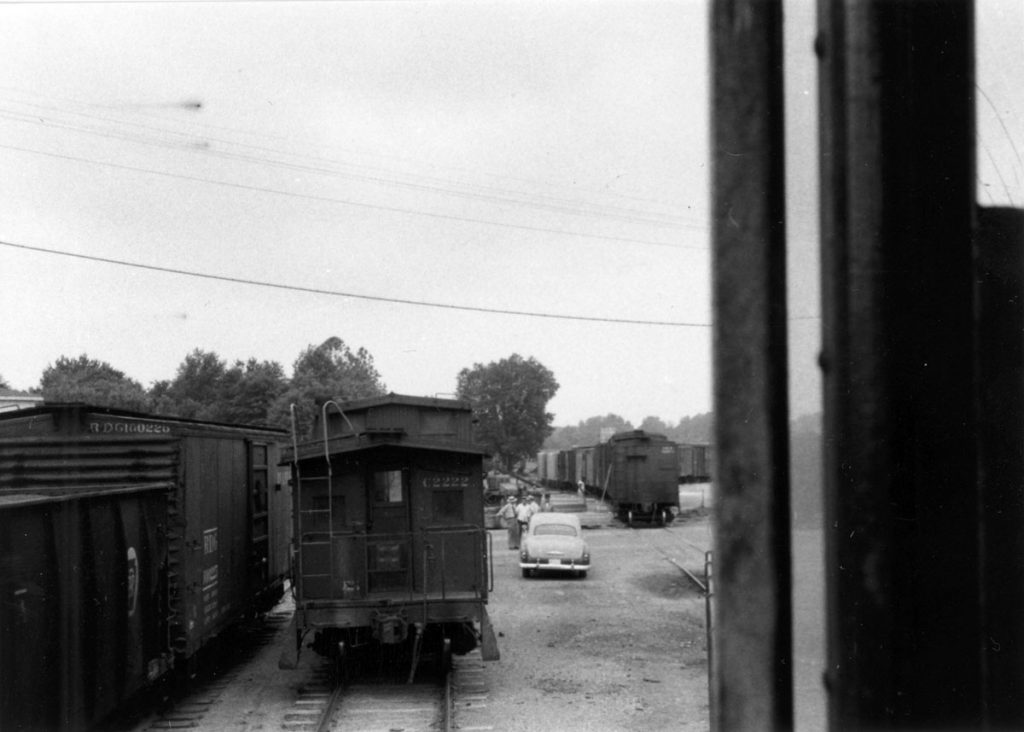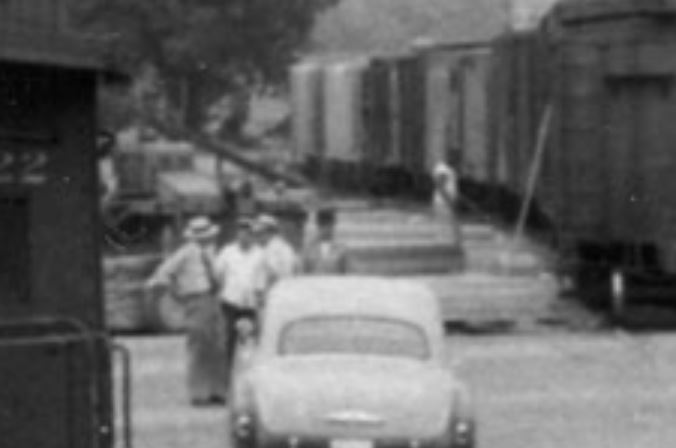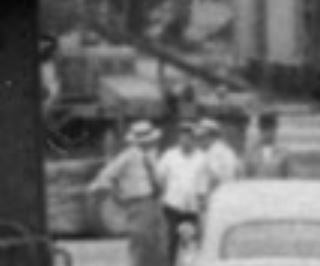Last weekend, while doing some research on track and industry layout in Bethesda with my friend Matt I was looking at a photo that I have looked at many, many times before and noticed something completely new and exciting. (don’t you love it when that happens?!) Here is the photo:

Looks pretty normal. A really full yard at Bethesda. The road crew, on an S2, a short distance from C2222, the “local” caboose that ran regularly on that assignment. In the background is Bethesda Avenue, with a car parked next to it, a few gentleman talking and some freight unloading going on in the background. Well, here’s the fun part. “Computer. Zoom and enhance!” (I love saying that.)

Immediately my brain triggered. “Hey! I know what that thing is! Look, do you see it?!” I exclaimed to my friend Matt, sitting next to me, looking befuddled. It’s a straddle carrier. A lumber straddle carrier. These neat vehicles were invented around 1913 and had four wheels which could turn independent of the others, allowing the vehicle to maneuver in tight spaces. The bottom is open and has arms which can grab a stack of lumber beneath it. Really brilliant. They were common in lumber yards around the country until the advent of the fork lift and palletized lumber. In some instances these vehicles are still used today and are even produced for specialized applications by some of the manufacturers who made them back then.

So why is this special?
Well, it’s another fine detail that brings the setting to life. Had I never zoomed in and noticed that tiny detail, I would have never known there was one in Bethesda. It means that in my modeling of the area I can include this distinctive vehicle and it will be prototypical. I love these things. They’re quirky and eye-catching. I have no other photos that I know of showing the straddle carrier in Bethesda, so it is rather special.
How was it used?
Well, I doubt it was used by the Einsinger Mill & Lumber Co, as they had their own siding into their yard. It very well COULD have been theirs, but there were several other lumber yards in the area (Devlin, for example) who may have used the straddle carrier to shuttle lumber to their yard just a short distance from the team tracks in Bethesda. You can see a gentleman stacking lumber to the right. The lumber would be delivered by boxcar as was common at the time. The lumber would be stacked and then the straddle carrier would drive atop the bundle, grasp it and then shuttle it to the yard for storage and sale.

I NEED YOUR HELP!
I want to identify the make of this carrier. I have been hunting high and low for a photo or reference to the specific unit pictured in this image. Look carefully at the engine cowl, the wheels, what appears to be shrouding over the front wheel mounts up top, the rear gear assembly/cover and front opening. Also, don’t be fooled by the silhouettes of the gentlemen in the foreground, especially the one to the right. Try to crop those out. Also note what appears to be a gas tank of some sort just behind the carrier. Is this part of the unit? I can’t tell. Distance-wise, remember this this is REALLY far from the photographer in the photo. The distances are really squished together at this distance. If you have any info that could help me, please email me at cpl_clegg at yahoo dot com.
Final Note
These kind of details revealing themselves are the things that keep me hunting for more and more photos, stories, maps and documents related to the Branch. It intrigues me and I enjoy it tremendously! One other thing I noticed, further back, beyond the straddle carrier there appears to be a bulk transfer conveyor loader. These were seen in just about every town and it’s no surprise there was one in Bethesda. One end of the conveyor would be placed beneath a hopper and a truck would be spotted at the upper end. Once turned on, the hopper would be opened and the contents loaded into the back of the truck. Think sand, gravel, etc.
One thing I notice in pictures of Bethesda yard from the 50s it seems that there was a whole slew of tracks in addition to the main line jam packed full of cars and stretching a few different directions over much of available space in the yard as well as the spur that ran (if I’m not mistaken) behind the concrete plant. Then in later photos from the 70s and 80s it seems there’s only just a couple of tracks, the main and a siding or two running through the yard, so did Bethesda gradually reduce or shorten the number of sidings it had throughout the years?
Yes, the number of sidings did diminish over the years. There was a lot of fluctuation. I imagine that the construction of the late 1800s to Bethesda had some rudimentary freight facilities. Over time, Bethesda grew up around the railroad. As more and more customers developed, the sidings were laid in. You can see several of them on the track chart linked in a more recent post from Jan 2019. I believe the Einsinger Lumber siding is one of the oldest. Over the years, as customers moved to further distant suburbs and the climate for industry changed, sidings were removed or shortened. Being that most of the real estate the yards in Bethesda existed in has been excavated, I doubt we’ll see many more rusty rails emerge. Besides the trail right-of-way in Bethesda, the only real remnant of the railroad are the “Bethesda Row” buildings which still stand. Other than that, adjacent to the RoW, there are very few structures which date back to the days of active RR service down there.